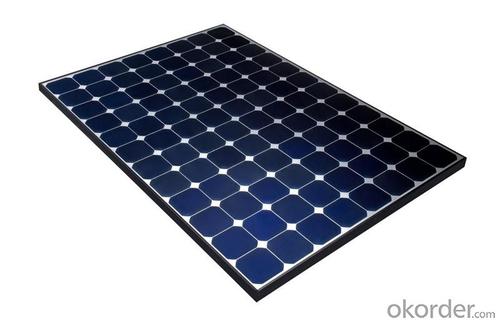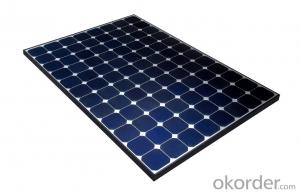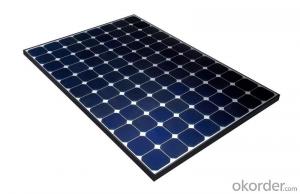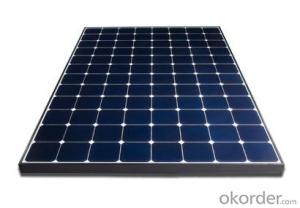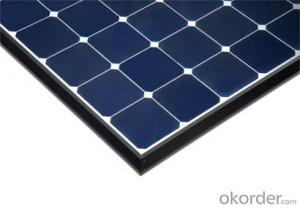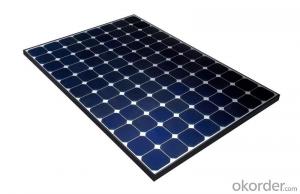24V CNBM Poly 205W Solar Panel with TUV UL CE Certificate for Residential
- Loading Port:
- Shanghai
- Payment Terms:
- TT OR LC
- Min Order Qty:
- 100 watt
- Supply Capability:
- 1000 watt/month
OKorder Service Pledge
OKorder Financial Service
You Might Also Like
Specification
CNBM Poly 205W Solar Panel with TUV UL CE Certificate For Residential
Introduction
Each module is rated by its DC output power under standard test conditions, and typically ranges from 100 to 365 watts. The efficiency of a module determines the area of a module given the same rated output – an 8% efficient 230 watt module will have twice the area of a 16% efficient 230 watt module. There are a few solar panels available that are exceeding 19% efficiency. A single solar module can produce only a limited amount of power; most installations contain multiple modules. A photovoltaic system typically includes a panel or an array of solar modules, a solar inverter, and sometimes a battery and/or solar tracker and interconnection wiring.
Micro-inverted solar panels are wired in parallel which produces more output than normal panels which are wired in series with the output of the series determined by the lowest performing panel (this is known as the "Christmas light effect"). Micro-inverters work independently so each panel contributes its maximum possible output given the available sunlight.[6
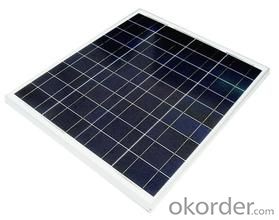
Suggested application
Home lighting business lighting,
Garden lighting, pavement lighting
Farmer household lighting
Decorative water pump
Traffic signal lighting
Industry area
Business area
Solar Power Plant
Product feature
Modules are made of Monocrystalline or Polycrystalline Silicon cell.
Materials and color of the solar panel frame: Clear anodized aluminum alloy type 6063T5 Universal frame; Silver-white color;
The output connection gathers the coupling: Selects conforms to the IEC-612615; 2005, class II, IEC61730 international standard; Airtight waterproofing binding clamp;
Module seal structure: The surface is thick, the high diaphanous rate armored glass with solar cell board special-purpose 3.2mm becomes after the high temperature lamination craft. The back selects has waterproof and anti- aged performance fine TPT materials. The entire block battery board has, the waterproofing, the anti- aging airtight and so on the fine performance;
Power tolerance: +/-3%
Packaging
International standard cartons (according to the requirements of customers)
- Q: I need to be able to charge a 2v 7amp battery with a solar panel. I understand that the charge controller will keep the battery from over charging/discharging, but what I don't understand is the amps.The solar panel is rated at 5watts.The solar panel comes with a 2v 3amp charge controller but will I need to buy a 7amp charge controller and replace it with that for my battery pack? Please explain. Thanks in advance.
- 7 Amp Solar Charge Controller
- Q: Can solar panels be used in areas with high levels of dust storms?
- Yes, solar panels can still be used in areas with high levels of dust storms. However, it is important to ensure regular maintenance and cleaning of the panels to prevent dust accumulation, which can reduce their efficiency.
- Q: Can solar panels be used for outdoor lighting?
- Yes, solar panels can be used for outdoor lighting. Solar-powered outdoor lighting systems use panels to convert sunlight into electricity, which is stored in batteries and used to power the lights during the night. This makes them a sustainable and eco-friendly option for illuminating outdoor spaces.
- Q: How do solar panels affect the property's energy management system?
- Solar panels can have a significant impact on a property's energy management system. By converting sunlight into electricity, solar panels can provide a clean and renewable source of power, reducing the property's dependence on traditional energy sources. This can lead to significant cost savings on electricity bills and also help to reduce the property's carbon footprint. Additionally, solar panels can integrate with the property's energy management system, allowing for better monitoring and control of energy usage, optimizing the overall efficiency of the system.
- Q: How much electricity can a solar panel produce?
- The amount of electricity a solar panel can produce depends on several factors, including the size of the panel, its efficiency, and the amount of sunlight it receives. On average, a standard 300-watt solar panel can generate around 300-400 kilowatt-hours (kWh) of electricity per month under optimal conditions. However, it's important to note that actual electricity production may vary based on location, weather conditions, and other variables.
- Q: my solar panel is 5v 50 mA, and im making iphone USB charger so i need to connect + with 00 ohm resister and to data - and + so what resister will be okay..?
- Just connect the 5 volts out of the panel directly to the iphone via an USB connector. BUT, is the panel output always 5 volts, ±0.25 volts? Because that is the USB specification, and anything outside of those values could damage your iphone. And solar panels are known for their wide swings in voltage. Bottom line, resistor not needed, and you need to be positive you supply the correct voltage to the iphone. Best way to do that is to start with a solar panel that puts out at least 7 volts and use a LM7805 regulator. The only resistors needed are those to tie the data lines into a certain combination of resistance and voltage so that the iphone is fooled into thinking that a proper USB is connected. That would NOT involve a 00 ohm resistor. Search online for the proper values and connections. edit: are you repeating your same inane question with a different account? That is totally against the rules and could get you suspended.
- Q: A few months ago my dad said something about getting solar panels, and how green they were. I was just wondering if there were any companies that sold them and if they would actually make a big difference.
- Yes there are companies that sell solar panels, many of them specialize in solar, a simple google search with your state or city name and the word solar should get you many results. There are actually two kinds of solar panels that get installed on homes, one kind creates electricity, the other heats up water. Depending on how large a system you installed, you could have all of your electricity or hot water powered by solar, which would mean you'd use less nonrenewable resources like coal, oil, or natural gas. The other difference the solar panels would make would be in your electric or gas bill, that number would go down right away, but you'd have to wait a few years before the money you save there would cover the cost of buying the panels, the number of years depends on your state, and the size of your system. Starting in January there will be a 30% federal tax credit, that would mean savings for every installation in the US. Also a lot of states now have a rebate program, which means the system is even less expensive.
- Q: Is there a material that is capable of absorbing enough UV radiation to make it worth using as a flexible solar cell?Not flexible as in aluminum, but a material such as plastic (polycarbonate).
- Yes it depends on the material of the bearings fixed, on the to be Moved pivots!/--Fulcrums/turning points/hinges.etc. but the wiring for commands has to reach them keeping them moveable in unhospitibale temperatures.The heating effect of an electric current is benificial too.
- Q: Can solar panels be installed on train stations?
- Yes, solar panels can be installed on train stations. In fact, many train stations around the world are adopting solar energy systems to power their operations and reduce their carbon footprint. Solar panels are installed on the roofs or canopies of train stations to harness sunlight and generate electricity, which can be used for lighting, heating, cooling, and other station facilities. This renewable energy source makes train stations more sustainable and helps in the transition towards a greener transportation system.
- Q: Can solar panels be used to power swimming pools?
- Yes, solar panels can indeed be used to power swimming pools. Solar panels can generate electricity from sunlight, which can be used to operate pool pumps, heaters, and other equipment, reducing the reliance on traditional electricity sources and saving on energy costs.
Send your message to us
24V CNBM Poly 205W Solar Panel with TUV UL CE Certificate for Residential
- Loading Port:
- Shanghai
- Payment Terms:
- TT OR LC
- Min Order Qty:
- 100 watt
- Supply Capability:
- 1000 watt/month
OKorder Service Pledge
OKorder Financial Service
Similar products
Hot products
Hot Searches
Related keywords


